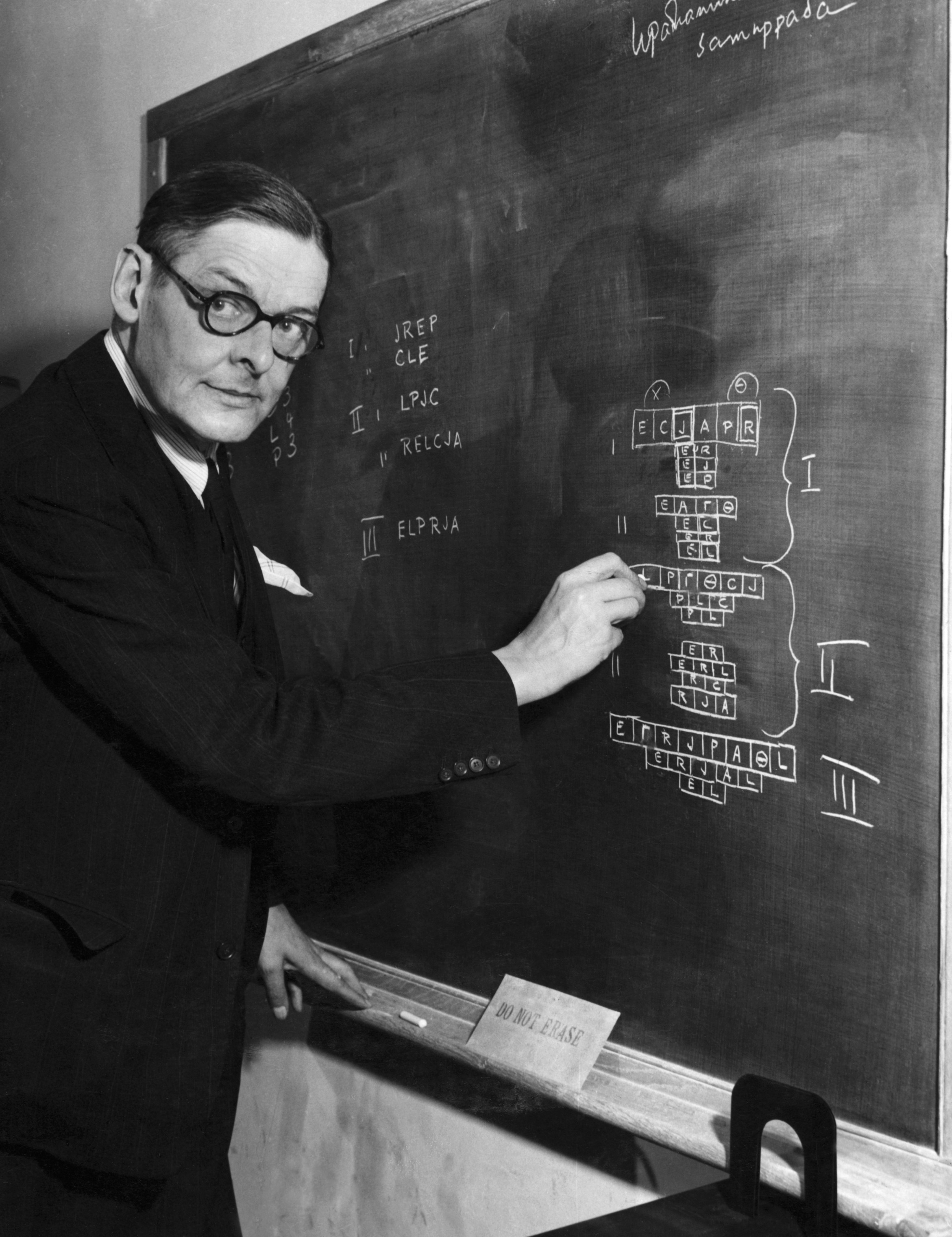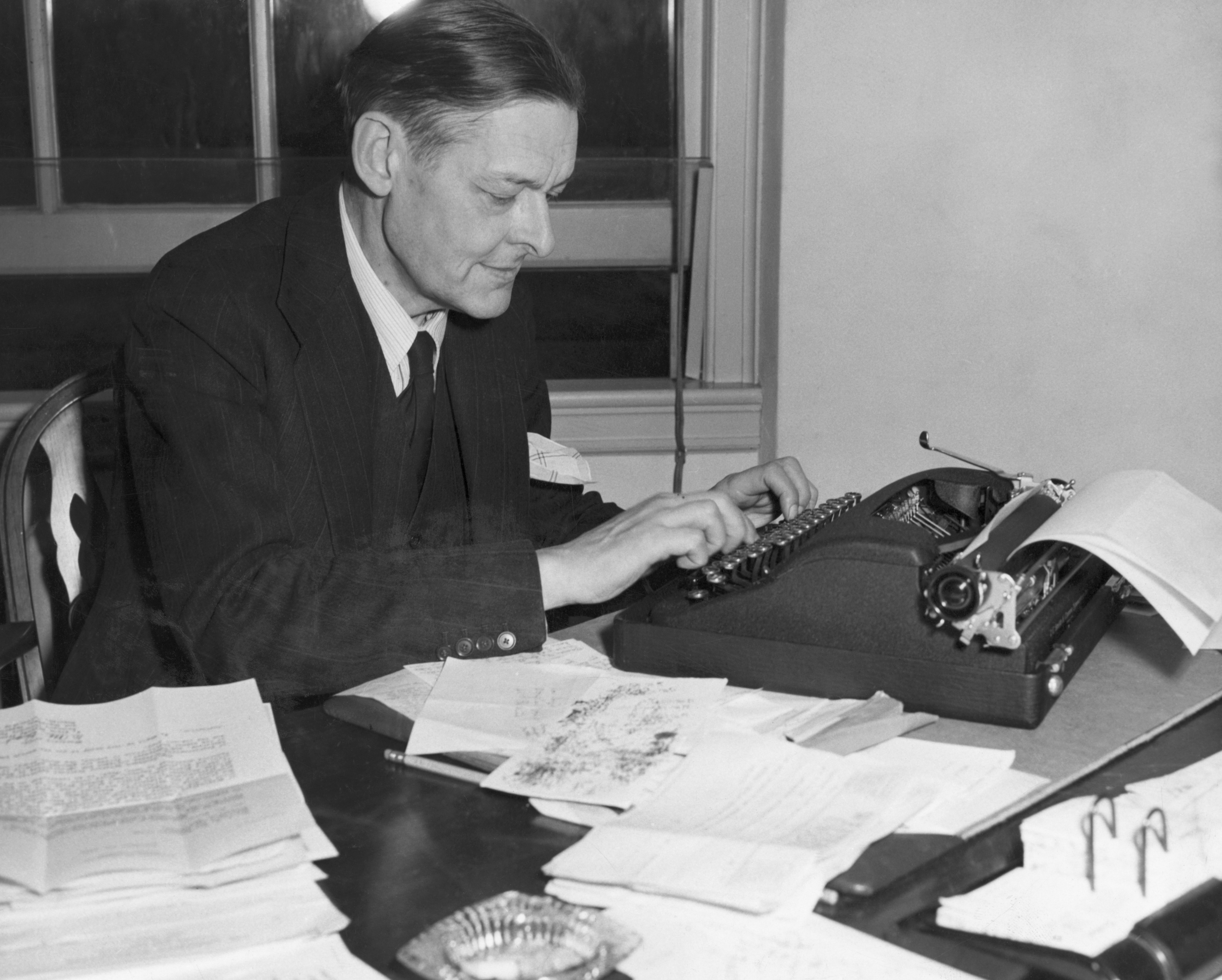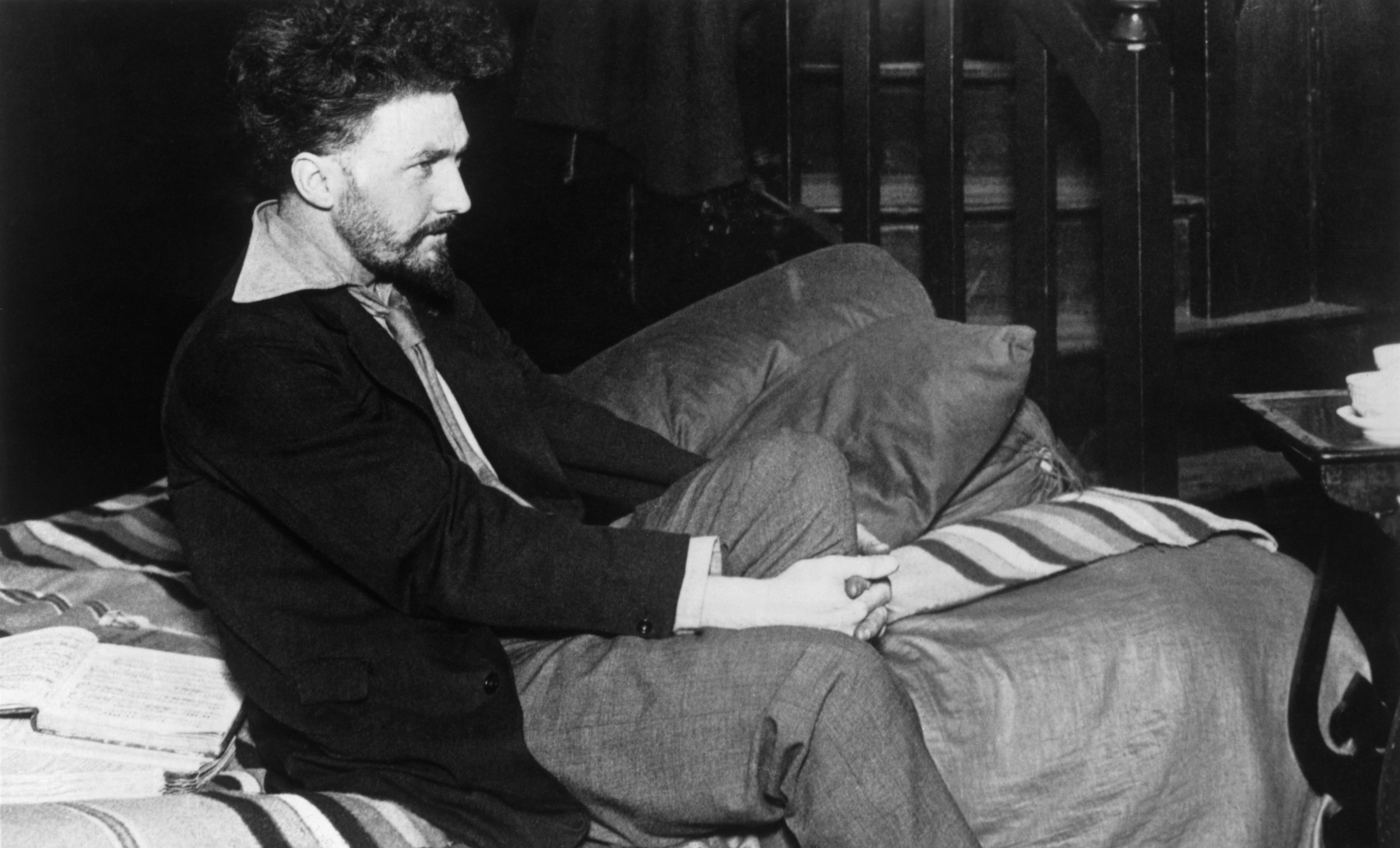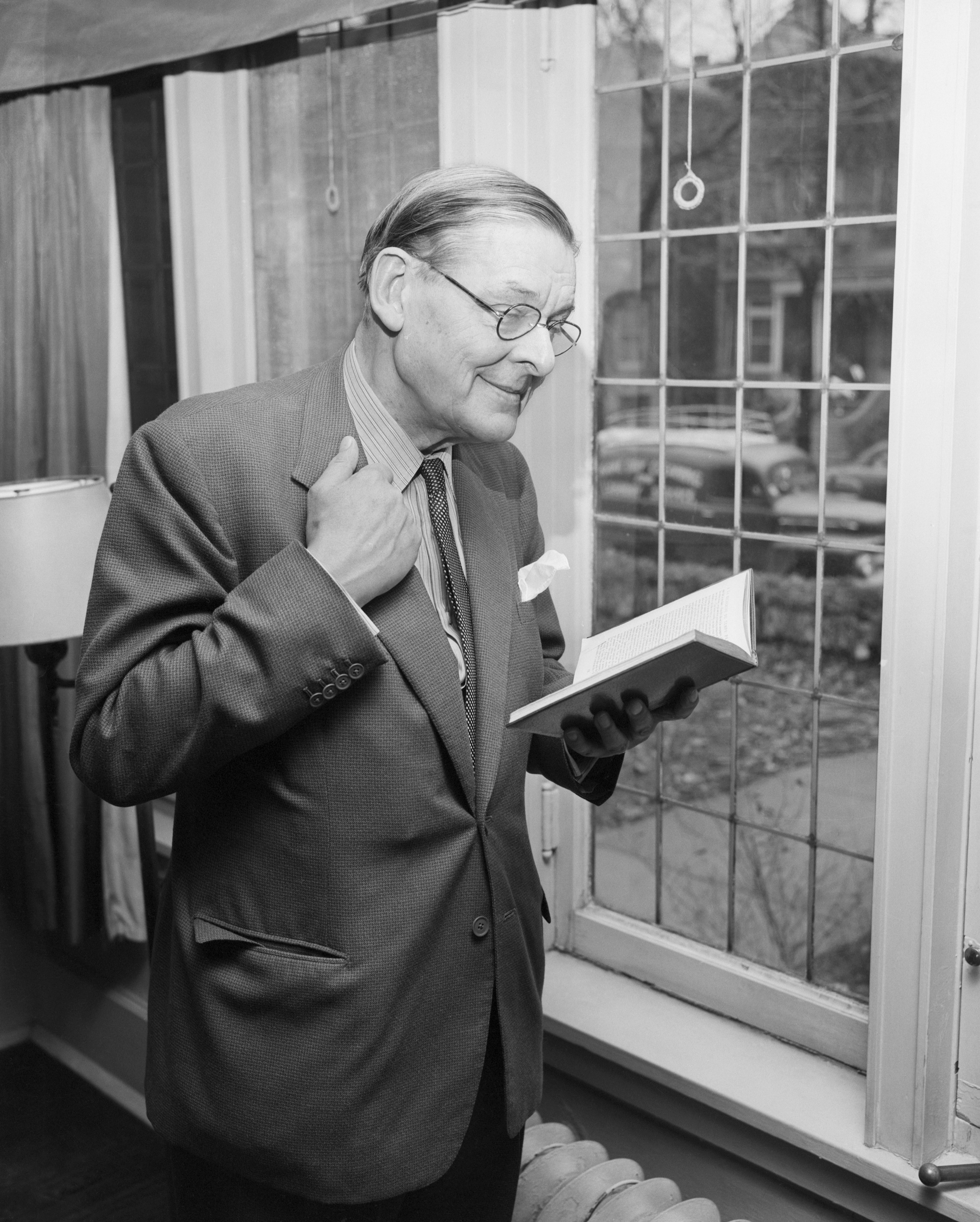Better Craftsmen, Not Gods
If Eliot is the poem’s mother, then perhaps Pound was right to claim the role of obstetrician:
“If you must needs enquire
Know diligent Reader
That on each Occasion
Ezra performed the Caesarean Operation.”Quote from Ezra Pound’s “Sage Homme,” a poem included in his December 24, 1921, letter to T.S. Eliot celebrating The Waste Land.
This online exhibit, Better Craftsmen, Not Gods, is a critical examination of the development of T.S. Eliot's The Waste Land. One manuscript of the poem, as annotated by Ezra Pound and Vivienne Eliot prior to the poem’s 1922 debut publications in The Criterion and The Dial, was lost and later rediscovered and added to the New York Public Library’s Henry W. and Albert A. Berg Collection. Written between 1919 and 1922 and twice the length of the poem as published, this manuscript included the five core movements of the final poem plus three additional, unpublished movements and eight more miscellaneous poems ranging from five to 73 lines that Eliot might have included in the book.
Written in dialogue between them, scholar Tyler Malone and digital archive editor Robert Eric Shoemaker track the development of The Waste Land through manuscripts and editorial correspondence among Eliot and his collaborators as a demonstration of the interrelation of this influential poem to other works and minds, thus illuminating the inherently collaborative and complex nature of the editing and crafting of poetry. The exhibit also addresses the personalities, prejudices, and politics that influence the legacy of poets who, for good and for ill, became canonical through their influence on others. Pound was a fascist sympathizer and some of Eliot’s writing to tokenized, stereotyped, and degraded others, particularly people of color and those of Jewish descent. Better Craftsmen, Not Gods asks readers to consider the influence of the canon on their own relationships to texts, to poets, and to the nature of being a responsible literary citizen in the 21st century.
The exhibit curators thank Carolyn Vega of the New York Public Library; Peter London of HarperCollins; and Francesca Wade, a scholar who assisted at the Yale Beinecke Library, for their invaluable help and support in researching this exhibit.
A special thank you to Meg Forajter, permissions coordinator at the Poetry Foundation, for her efforts to acquire permissions for all the materials in the exhibit.
NAVIGATION
View the slideshow above to walk through this exhibit.
In order below, you will find:
Tyler Malone’s introductory essay on “The Waste Land”
Exhibit partners and links to additional Waste Land 100 content
Poets involved in the publishing of The Waste Land
T.S. Eliot’s influences and acolytes
BETTER CRAFTSMEN, NOT GODS
By Tyler Malone
In an office, cold and sterile—or, for all we know, on a stroll in some pleasant garden—Dilston Radcliffe, a poet time forgot, asked his analyst, Homer Lane, a question. Radcliffe’s friend Conrad Aiken had asked Radcliffe to ask the question on behalf of Aiken’s friend T.S. Eliot, though Aiken did so without Eliot’s knowledge.
At the time, Aiken was in London, living in Bayswater and lunching a few times a week with Eliot, who always carried a pocket edition of Dante as a talisman while walking through that unreal city.
The two often ate at a favorite pub near Cannon Street Station not far from Lloyds Bank, where Eliot worked as a clerk in the Colonial & Foreign Department. They would discuss “the literary scene, with some acerbity and hilarity, and with the immense advantage of being outsiders.”
The two fledgling poets knew one another from their Harvard school days, studying under, among others, George Santayana, who had shown them a “view of what poetry would ultimately be.” Aiken had, “very generous friend” that he was, introduced Eliot to Ezra Pound years earlier. This introduction led to Pound’s mentorship of Eliot and, at Pound’s instigation, the publishing of “The Love Song of J. Alfred Prufrock” in the June 1915 issue of Poetry.
During one particular lunch over grilled rump steak and a pint of Bass ale, Eliot, who for some time had been in the throes of a nervous breakdown, complained that “the sharpened pencil lay unused by the untouched sheet of paper.” In other words, he was experiencing the age-old foe of the poet: writer’s block. He felt the material was there, buried within, but it would not surface. Naturally, this worried him, and Eliot’s worry worried Aiken, so he asked Radcliffe to ask Lane that important question: what might be the matter with his dear friend and could anything be done about it?
Lane’s response was simple: “Tell your friend Aiken to tell his friend Eliot that all that’s stopping him is his fear of putting anything down that is short of perfection. He thinks he’s God.” When Aiken relayed this diagnosis to Eliot, who hadn’t known that he had told Radcliffe or that Radcliffe had told Lane, Eliot felt his friend had committed an intolerable intrusion by discussing his dilemma with anyone else. “But ever since,” Aiken later wrote, “I have been entirely convinced that it did the trick, it broke the log-jam. A month or two later Eliot went to Switzerland, and there wrote The Waste Land.”
Of course, the creation of The Waste Land was a years-long, intricate process. It didn’t just emerge, fully formed, like Athena from the head of Zeus, simply because of Aiken’s relaying of Lane’s astringent advice. In fact, matching up the chronology of this event with other known facts about the crafting of The Waste Land is difficult and may prove the anecdote apocryphal.
Eliot had been working on the poem for approximately two years—though how much of it was written in 1919 and 1920 is anyone’s guess—the critical consensus argues not much, but no one knows exactly how many fragments had already been shored against his ruins.
During those two years, Eliot focused mainly on “gradually putting a prose book together.” The Sacred Wood, a collection of his essays, was published in November 1920. Though it did receive some good reviews, the mostly lackluster response to his literary criticism disappointed Eliot greatly. By the end of the year, he claimed to be “rather tired of the book now, as I am so anxious to get on to new work.”
Earlier in the autumn of 1920, Eliot had written to his mother, “I want a period of tranquility to do a poem that I have in mind.” His job at Lloyds Bank, unfortunately, rarely afforded him the time. Pound wrote to art collector John Quinn that year: “No use blinking the fact that it is a crime against literature to let [Eliot] waste eight hours vitality per diem in that bank.” But Eliot’s job was the least of his worries. He and his wife, Vivienne, tended to her father when he became gravely ill, nursing him night after night. That soon resulted in Vivienne’s own nervous breakdown. In July 1921, she wrote to Scofield Thayer, editor of The Dial: “My mind has left me and I am becoming gradually insane.” Vivienne was sent to the country under medical orders. At the same time, Eliot’s mother, sister, and brother visited him for the summer, but anxiety about having to hide his marital problems and keep up appearances for his family consumed him. After they left, he wrote to Richard Aldington that he felt “very shaky” and that his health seemed “to have gone down rapidly.” By autumn of 1921, Eliot had consulted a nerve specialist about his health: “I have seen the specialist (said to be the best in London) who made his tests, and said that I must go away at once for three months quite alone, and away from anyone, not exert my mind at all, and follow his strict rules for every hour of the day.”
On October 12, 1921, Eliot was given three months of sick leave from Lloyds Bank because of his tenuous mental condition. First he moved to Margate, staying at the Albemarle Hotel in the coastal area of Cliftonville, where for three weeks he worked on The Waste Land—the working title was He Do the Police in Different Voices, a reference to Our Mutual Friend, by Charles Dickens. How much was written in Margate is uncertain but presumably “The Fire Sermon” section and pieces of some of the others—the poem was then well into its fetal development.
When he left Margate, Eliot passed through Paris and visited the Pounds. That was presumably when he first let Pound see what he had been working on. He then left for Lausanne, Switzerland, to seek help from Dr. Roger Vittoz. When Eliot shared his Lausanne draft with Pound, his friend called it “the 19 page version,” implying that much had been added in the time in Lausanne. On that Lausanne manuscript, Pound made copious notes—most crucially, cutting huge chunks of the poem. Though Pound could be ruthless in his notes and cuts—“verse not interesting enough as verse to warrant so much of it”—he clearly saw there was something special in this manuscript, like the half-formed bust glimpsed in a block of marble. Even before its publication, Pound claimed that “Eliot’s Waste Land is I think the justification of the ‘movement,’ of our modern experiment, since 1900.”
When The Waste Land was published in October 1922—first in Eliot’s own little magazine, The Criterion; the following month in Scofield Thayer’s (The Dial); and last in book form accompanied by a section of notes—few knew what to make of it. “I think it is a piece of tripe” was Amy Lowell’s opinion. Clive Bell felt the poem did not deliver on the “immense hopes” roused by “The Love Song of J. Alfred Prufrock.” In the New Statesman, F.L. Lucas declared that a “poem that has to be explained in notes is not unlike a picture with 'This is a dog’ inscribed beneath.” But the favorable reviews of Edmund Wilson and Conrad Aiken (“The Poetry of Drouth” and “The Anatomy of Melancholy,” respectively) heaped praise on the poem, which quickly became as defining an achievement of modernism as James Joyce’s Ulysses, which was published serially from 1918–1920 and in full in 1922, inviting equal amounts of praise and scorn.
Ironically, both positive reviews perturbed Eliot, though for different reasons. Responding to the title of Aiken’s essay, Eliot told his friend over lunch “There is nothing melancholy about it!” Aiken, realizing that his companion had missed the intended allusion, responded: “The reference, Tom, was to Burton’s Anatomy of Melancholy, and the quite extraordinary amount of quotation it contains!”
Though he certainly appreciated Wilson’s praise—“I doubt whether there is a single other poem of equal length by a contemporary American which displays so high and so varied a mastery of English verse”—Eliot felt that the critic had disparaged Pound’s poetry in comparison to his. In writing to a mutual friend, Eliot asked that the following message be passed on to Wilson:
“There is one point in Mr. Wilson’s article to which I must strongly take exception. I do very much object to be made use of by anyone for the purpose of disparaging the work of Ezra Pound. I am infinitely in his debt as a poet.”
As the stature of the poem grew in the decades that followed, Pound’s role in the creation of The Waste Land became the stuff of legend. To unfamiliar readers, the most obvious sign of Pound’s involvement is in the poem’s dedication: “For Ezra Pound / il miglior fabbro.” By calling Pound, “the better craftsman,” as it is often translated, in his Dante-referencing dedication, Eliot tipped his hat to what many in the literary scene had already heard: that Pound had helped Eliot craft the poem and that Pound’s part in the process was perhaps more extensive than mere “editor.”
Eliot never denied Pound’s deep involvement in the poem’s creation—quite the contrary. He claimed his mentor “was so passionately concerned about the works of art which he expected his protégés to produce that he sometimes tended to regard them almost impersonally, as art or literature machines to be carefully tended and oiled, for the sake of their potential output.” Though the Lausanne draft with Pound’s notes had long been lost, Eliot confessed, “I should like to think that the manuscript, with the suppressed passages, had disappeared irrecoverably: yet on the other hand, I should wish the blue pencilling on it to be preserved as irrefutable evidence of Pound’s critical genius.”
In 1959, as part of his The Art of Poetry interview with poet Donald Hall for the Paris Review, Eliot admitted that “at that period” of his poetic development, he greatly “benefitted” from Pound’s collaboration: “He was a marvelous critic because he didn’t try to turn you into an imitation of himself. He tried to see what you were trying to do.” Though he did not think Pound’s excisions changed “the intellectual structure of the poem,” Eliot conceded that his longer version “was just as structureless, only in a more futile way.”
Years earlier, when he first met Eliot, Hall was so overwhelmed by the man’s presence that he was sure he said nothing of any intelligence to Eliot. They talked for an hour, until Eliot “scraped back his chair a little,” which Hall took as a sign. So, pretending it was his idea, he leaped up to go. But Eliot lingered with him in the doorway for a beat: “Forty years ago, I was going from Harvard to Oxford, now you are going from Harvard to Oxford, what advice may I give you?” Hall waited for some deep guidance from the great poet he called “the king of the mountain.” Eliot said—“with a comedian’s exact pause”—simply “Have you any long underwear?”
That’s the thing: Eliot and Pound were funny. “Complimenti, you bitch. I am wracked by the seven jealousies,” Pound wrote to Eliot after having read The Waste Land. Though we usually think of these two men—and the whole pantheon of canonical writers—as graven images, statues of god-like artists, remembering that they were just people with desires and anxieties, eccentricities and prejudices, problems and successes is important. Through what one can read of the pair’s dialogue, with its polyglot flair, inside jokes, and playful ribbing, in the Lausanne manuscript and their many letters, the idols become flesh anew.
In the Paris Review interview, Hall asked Eliot whether the Lausanne draft still existed somewhere, and Eliot replied, “Don’t ask me. That’s one of the things I don’t know. It’s an unsolved mystery. I sold it to John Quinn. I also gave him a notebook of unpublished poems, because he had been kind to me in various affairs. That’s the last I heard of them. Then he died and they didn’t turn up at the sale.”
The mystery wasn’t solved until October 1968: the New York Public Library announced that its Berg Collection had acquired the original manuscript of The Waste Land. A few years later, in 1971, Valerie Eliot, the poet’s second wife and widow, prepared a printed edition of the facsimile and transcript so the public could finally peer behind the curtain of a 20th-century masterwork.
The evidence of Pound’s contributions hasn’t much altered the mythos surrounding the text one way or the other. Some still diminish Pound’s contributions, and others oversell them. Decades after the publication, an English professor in a graduate seminar I took referred to The Waste Land as “the best poem Ezra Pound ever wrote.” He surveyed the room to gauge students' reactions: some wrinkled their faces in confusion, others laughed, a few stared out the window, bored by the provocation.
It is easy—and, perhaps, natural—to gaze upon a work such as The Waste Land as one might gaze upon a vast desert’s setting sun, whose symphony of hues might seem to primitive people the marvelous work of god(s). But as a million meticulous happenstances must have occurred in tandem for the sun to spill pink liqueur across a sky, so too must innumerable incidents happen for a Waste Land. This exhibition highlights some of the major and minor moments in the creation of one of the great poems of modernism, including correspondence with Virginia Woolf, Pound’s distinctive editorial comments, and Conrad Aiken’s review. Unlike my professor, we do not usurp authorship from Eliot and give it to Pound, but we look at the poem as a textual process—with Pound taking on a role almost as central as Eliot’s own. If Eliot is the poem’s “mother,” then perhaps Pound was right to claim the role of “midwife”: “If you must needs enquire / Know diligent Reader / That on each Occasion / Ezra performed the Caesarean Operation."
On the 100th anniversary of The Waste Land, this exhibit celebrates the meticulous craft and artistic conversation that took place a century ago between this poem’s parent and its obstetrician. We hope that in doing so we do not dim the poem’s resplendent gloaming, but merely elucidate the processes behind that idiosyncratic glow. For this is the work of better craftsmen, not gods.
This exhibit was made possible in collaboration with other institutions, researchers, archivists, librarians, and publishers who enthusiastically drove our work forward. We would especially like to thank:
- The New York Public Library and Carolyn Vega, curator of the Henry W. and Albert A. Berg Collection of English and American Literature at the New York Public Library
- Please visit the NYPL Treasures Exhibit, which features stories of T.S. Eliot and Virginia Woolf: September 2022–January 2023.
- HarperCollins and representative Peter London
- Faber and the T.S. Eliot Estate
- Please visit Faber's The Waste Land centenary celebration page
- New Directions and the Ezra Pound Estate
- W. W. Norton & Company
- The Newberry Library in Chicago
- The University of Michigan, repository for The Dial archives
As always, thank you, readers, for your support of the Poetry Foundation and our archival work. We hope you enjoy this dig with us.
—Robert Eric Shoemaker and Tyler Malone
Eliot, Pound, and other Modernists were inspired by the works of ancestral poets, including those of the ancient world. As a project, modernism balanced the poles of contemporary life and modern anxieties with the allure of tradition and canon. Included here are some of the works that inspired Eliot’s poetry.
-
Dante Alighieri
-
Dante Alighieri
-
William Blake
-
Jules Laforgue
-
Walt Whitman
Just as Modernists were inspired by the work of their forebears, they also read their contemporaries. Eliot spoke frequently with other writers, including James Joyce, with whom Eliot corresponded as both were writing their “masterworks.” Eliot also read the works of other poets published by the same presses and journals as himself, including Hope Mirrlees, whose Paris was published by Virginia Woolf. Here is a selection of Eliot’s contemporaries that may have inspired aspects of The Waste Land.
-
Ezra Pound
-
Ezra Pound
-
Ezra Pound
-
Conrad Aiken
Writers since Eliot have followed Pound’s dictum to “make it new” by riffing and improvising on Eliot’s work. Here are some aftershocks of The Waste Land.
-
Hart Crane
-
Allen Ginsberg
-
John Beer
Included in alphabetical order
Ackroyd, Peter. T.S. Eliot: A Life. Simon & Schuster, 1984.
Aiken, Conrad. Selected Letters of Conrad Aiken. Yale UP, 1978.
Bell, Clive. “T.S. Eliot.” The Nation andAthenaeum, 772–773 (September 22, 1923).
Brown, E. K. “Mr Eliot and Some Enemies.” University of Toronto Quarterly 8, 69–84, October 1938.
Butscher, Edward. Conrad Aiken: Poet of the White Horse Vale. University of Georgia Press, 1988.
Cox, C. B., A. E. Dyson, and Arnold P. Hinchliffe, editors. T.S. Eliot: The Waste Land—Casebook Series. Aurora Publishers, 1970.
Eliot, T.S., interviewed by Donald Hall. “The Art of Poetry” The Paris Review 21, Spring-Summer 1959.
Eliot, T.S. “The Social Function of Poetry.” From On Poetry and Poets. Farrar, Straus and Cudahy, 1957.
Eliot, T.S. The Waste Land. Edited by Randy Malamud. B&N Classics, 2005.
Eliot, T.S. The Waste Land. Faber and Faber, 1922.
Gallup, Donald. T.S. Eliot & Ezra Pound: Collaborators in Letters. Wenning/Stonehill, 1970.
Gordon, Lyndall. Eliot’s Early Years. Oxford University Press, 1977.
Gordon, Lyndall. T.S. Eliot: An Imperfect Life. W. W. Norton, 1998.
Lucas, F. L. “The Waste Land.” New Statesman 22, 116–118 (November 3, 1923).
Luongo, Robert. The Gold Thread: Ezra Pound’s Principles of Good Government and Sound Money. Strangers Press, 1995.
Mirrlees, Hope. Collected Poems: Hope Mirrlees. Edited by Sandeep Parmar. Carcanet Press, 2011.
Wagner-Martin, Linda editor. T.S. Eliot: A Collection of Criticism. McGraw-Hill, 1974.
Wilson, Edmund, Jr. “The Poetry of Drouth,” the Dial volume 73.6. pp. 611–616, December 1922.
Included in order of appearance in exhibition
Topolski, Felikz. Sketch of T.S. Eliot. Published in Topolski’s Chronicle, Vol X, 1962.
Eliot, T.S. to Virginia Woolf. Personal correspondence dated 1923. Digital reproduction provided by the Henry W. and Albert A. Berg Collection of English and American Literature, The New York Public Library (https://archives.nypl.org/brg/19153#detailed). Reprinted by permission of Faber and Faber, Ltd.
Pound, Ezra to T.S. Eliot [Letters 181 and 182]. Digital reproduction from the T.S. Eliot papers at Houghton Library, Harvard University (https://hollisarchives.lib.harvard.edu/repositories/24/resources/2751). Reprinted by permission of New Directions Publishing Corporation and the Ezra Pound Literary Estate.
Eliot, T.S. to Ezra Pound. Personal correspondence circa 1921. Digital reproduction from the T.S. Eliot papers at Houghton Library, Harvard University (https://hollisarchives.lib.harvard.edu/repositories/24/resources/2751). Reprinted by permission of Faber and Faber, Ltd. Transcripts from The Selected Letters of Ezra Pound: 1907-1941. New Directions, 1971.
Eliot, T.S. to John Quinn. Personal correspondence, dated August 21, 1922. Digital reproduction from the John Quinn papers at the Manuscripts and Archives Division, The New York Public Library (https://archives.nypl.org/brg/19153#detailed). Reprinted with permission of Faber and Faber, Ltd.
T.S. Eliot, The Waste Land from the Dial, vol. 73, July–December 1922: pp. 473–485. Public domain. Digital reproduction provided by the University of Michigan Library.
Conrad Aiken, “The Anatomy of Melancholy” from the New Republic, vol. 33, 1923: pp. 294–295. Public domain. Digital reproduction provided by the Newberry Library, Chicago.








